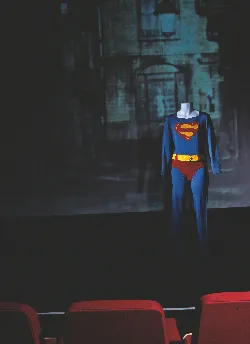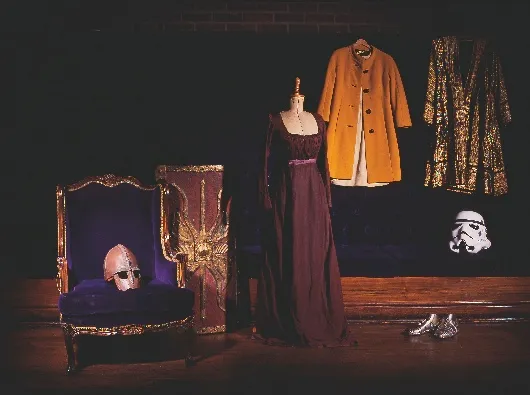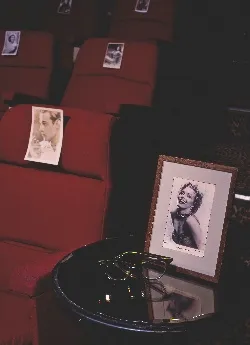Hollywood films, from the box office smashes of the golden era of cinema (1930s-60s) to the blockbuster movies of the present day, have always inspired fans to collect memorabilia. Iconic props and costumes, posters and signed photos are just a few of the items that remind us of our favourite flicks and most adored stars.
‘The finest posters are works of art,’ says George Galbraith, a graphic designer from Belfast who has been collecting vintage movie posters for over two decades. ‘They provide a dynamic and vibrant snapshot of what happens in the film.’ One of the highlights of his collection is a UK quad (a 30in x 40in) poster for Spartacus (the 1960 epic starring Kirk Douglas) showing a pair of scantily clad gladiators locked in combat.

Collectors need to be savvy and avoid reproduction items (repro posters are particularly common), which are temptingly cheap. Authentic memorabilia is an investment and prices start at around £100 for a signed photo of a well-known star, while a 21st-century original poster can cost less than £50.
Contemporary advertising and posters
Original advertising is the most popular area of movie memorabilia, especially with celebrity fans such as comedian Paul Merton, who purchased a poster of the Hitchcock film Rear Window (1954) from dealer Adrian Cowdry.
Posters are available in a range of sizes, which vary according to the country that the posters were produced in, and when they were made. Due to this it can be difficult to declare a poster a fake on the grounds of its dimensions alone. Some poster sizes were dropped: US window cards, 14in x 22in (mainly used attached to telegraph poles) were phased out in the Seventies, and US inserts, 14in x 36in (inserted into display cases in cinema lobbies), were phased out in around 1983. After 1985, one-sheet posters became the most commonly produced form.
Because of their popularity, some films have attracted more than their fair share of fakes: Blade Runner, The Empire Strikes Back and Return of the Jedi are among the most copied, so only buy posters relating to these films from a good dealer.
Collectors should be aware of the colour of the paper too, warns dealer Adrian Cowdry, and some US inserts are to be avoided. ‘We call them “minty whites”,’ he says. ‘If you turn them over and the card is bright white, they’re likely to be brand new, reprinted versions.’

The classic pitfall is buying a reissued poster for the price of an original. Every time a film was re-released, the posters were replicated or redesigned; later versions are worth less. Posters were also altered subtly according to country. Posters issued in the film’s country of origin enjoy the highest value, but the posters plugging the same film elsewhere in the world offer a cheaper alternative. An early 1950s French poster for Gone With The Wind, 47in x 63in, featuring artwork by Roger Soubie, is worth around £500 while the real deal – a 1939 original – is worth 10 times that amount.
Collectors usually buy posters according to the films or stars they depict, but a handful of poster artists have a following in their own right. The work of Tom Chantrell, who designed the British Star Wars posters (1977), is highly collectable, as is the graphic designer Saul Bass, whose poster for Hitchcock’s Vertigo (1958) is regarded as a classic. Currently, the Universal ‘monster movies’ of the 1930s are enjoying a renaissance with collectors: a Bride of Frankenstein (1935) one-sheet just sold for over $300,000 (approx £145,000) at auction in Texas (Heritage Auction Galleries).
Even modern posters are worth collecting. A poster for Spider-Man featuring the twin towers, which was withdrawn after September 11th, can be snapped up for less than £50 and could increase in value in the future.

Old favourites
There’s a keen market for props and costumes from the best-loved movies. In 2005, Dorothy Gale’s (Judy Garland) gingham dress from The Wizard of Oz (1939) sold for £143,500 at Bonhams. The auction record goes to a pair of Dorothy’s ruby slippers from the film, which sold for £412,000 in 2000, at an auction of Hollywood memorabilia auction at Christie’s in New York.
Couture at the movies
Some of the most collectable 20th-century costume and props have a double fascination, because of the big-name couturiers recruited to design them. Costumes worn by Milla Jovovich and Bruce Willis in Luc Besson’s sci-fi film, The Fifth Element (1997), for example, were created by French fashion designer Jean Paul Gaultier. A black dress designed by Hubert de Givenchy and worn by Audrey Hepburn in Breakfast at Tiffany’s (1961) broke records when it sold for £410,000 at Christie’s in 2006. Givenchy is thought to have been the first famous designer to work in film; costumes had previously been created by in-house designers.
Not all props are as pricey though. Jeremy Angel, whose family has run London-based prop and costume house Angels for six generations, has a shield featured in the Elizabeth Taylor epic, Cleopatra (1963), which he values at just £100. ‘Condition is important for value,’ he says, ‘but it also depends on the piece. Some costumes are distressed for the film, but as long as the poor condition is authentic buyers aren’t put off.’ Other good sources for film props and costumes include The Prop Store of London, auctioneers Bonhams and Christie’s, and London-based textiles auctioneer Kerry Taylor.
The most famous collectors are those already working in film and TV, such as film director Peter Jackson (maker of the Lord of the Rings trilogy), who sold much of his collection in December 2013, and TV producer and ex-husband of Liza Minnelli, David Gest. Star Wars pieces are especially scarce, because their most ardent collector, the film’s writer and director George Lucas, rarely allows them to reach the open market. In 2007, however, Bonhams sold Obi-Wan Kenobi’s cloak worn by Alec Guinness for £54,000.
Snapshots of glamour
Nothing is as evocative of the glamour of Hollywood as the studio photographs of the actors of the 1930s, 1940s and 1950s. Some of the most prized compositions are double portraits of stars such as Fred Astaire and Ginger Rogers; Humphrey Bogart and Lauren Bacall; James Stewart and Grace Kelly, especially if they were signed.
This field is beset by fakes, though, and collectors must tread carefully. Sarah Hodgson, former head of Christie’s’ entertainment memorabilia department advises: ‘Look for signs of age. If the photo looks completely pristine, you have to question whether it is original. Generally, old photos have a fusty smell. Consider the price too,’ she adds.
‘If you are offered an autographed Marilyn Monroe photo for under £500, it is too good to be true. Walk away.’
Autographs can be simple fakes, copies produced by autopens (look for perfectly even ink flow), or secretarial signatures, signed by the star’s staff. Fans sending away for an autographed photo would almost certainly have received pictures with secretarial signatures. If a provenance says an autograph was obtained from the star in person, it is more likely to be authentic.

Top prices are commanded by Marilyn Monroe: a good early signed studio publicity portrait from Gentlemen Prefer Blondes (1953) could achieve as much as £12,000, depending on condition and provenance. On a smaller budget, a sepia head-and-shoulders shot of Douglas Fairbanks Junior, who played Rupert of Hentzau in The Prisoner of Zenda (1937), can be had for under £100.
WHERE TO BUY
Christie’s South Kensington, London (020 7389 2820) hold a specialist entertainment sale. Its next sale will be an online-only film poster sale on 27th October 2015.
Bonhams, New Bond Street, London (020 7468 8200) hold twice yearly entertainment memorabilia sales. Richard Attenborough's collection of movie memorabilia will be sold there on 21st October 2015.
Posters
Silver Screen Memorabilia, (07717 131 407)
Michael Best, 0797 123 0362/ 01639 830369
CineArt Gallery (020 7384 0728)
Limelight Movie Art (020 7751 5584; limelightmovieart.com)
Props and costumes
The Prop Store of London (01494 766485)
Angels (020 7836 5678)
Kerry Taylor Auctions (020 8676 4600; kerrytaylorauctions.com)
Signed photos
Fraser’s Autographs (020 7836 9325)
What to read
Miller’s Movie Collectables by Rudy and Barbara Franchi (Miller’s Guides, 2002)
WORDS: Katrina Burroughs
PHOTOGRAPHS: Uli Schade
